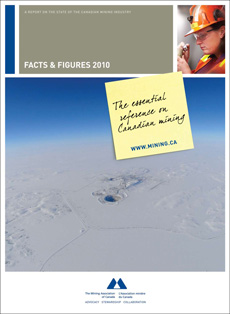 THUNDER BAY – As long as the provincial government understands that Northwestern Ontario has a future as a mining economic power, the future of the industry in our region should remain solid.
THUNDER BAY – As long as the provincial government understands that Northwestern Ontario has a future as a mining economic power, the future of the industry in our region should remain solid.
This week, the Mining Association of Canada (MAC) is celebrating the fortieth anniversary of the annual Facts & Figures report. Widely regarded as the essential guide to the mining industry, the publication chronicles domestic and global issues facing the industry and details the production, reserves, exploration, trade & investment, innovation, tax, and human resource aspects of the mining sector.
Facts & Figures 2010 underscores the importance of the industry to the Canadian economy. The sector contributed $32 billion to Canada’s GDP in 2009 and employed 307,000 workers. Importantly, the industry provided business to over 3200 companies supplying goods and services ranging from engineering and geo-technical services to drilling and processing equipment. The document also notes the competitiveness challenges facing the Canadian industry at the raw materials and value-added stages- including declining levels of domestic mineral reserves, inefficient Canadian project review processes, and growing scale of foreign smelters.
“Minerals and metals help build the products and infrastructure essential to modern life. This output is also fundamental to the emergence of clean energy technologies such as hybrid vehicles and lightweight materials,” said Gordon R. Peeling, President and CEO of the Mining Association of Canada. “Facts & Figures 2010 provides an excellent overview of the issues, challenges and activities of the Canadian mining industry – in Canada and abroad”.
While the industry is important in small communities, it also generates prosperity in our larger cities with Vancouver, Calgary, Edmonton, Saskatoon, Toronto and Montreal each featuring areas of global mining leadership. The industry is one of the largest private employers of Aboriginal Canadians with potential to further increase this relationship. The industry is also an important contributor to government coffers – paying over $10 billion in taxes and royalties annually to governments in years of strong mineral prices.
Facts & Figures 2010 highlights recommended changes and improvements to public policy, including:
- Tax policies and improvements are needed to help enhance exploration spending, develop new mines, extend mine life and encourage capital investment in efficient companies and facilities
- Strategic government investments in human resources, skills, geological mapping and infrastructure are needed to support the long-term prospects and vibrancy of the industry.
The global nature of the industry, and the high flow of international trade and investment, requires the federal government to be vigilant in ensuring that the degree of openness granted by Canada is reciprocated in other countries.
